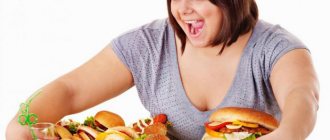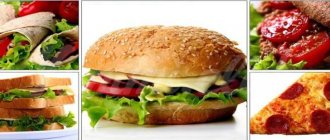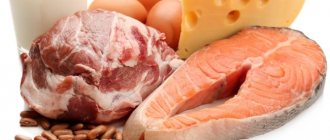How to correctly combine foods when eating separately. Basic principles of building a diet. Examples of food compatibility. The principles of separate nutrition say that food rots and is not digested if it is consumed in conjunction with food that requires other enzymatic activity. But the human digestive tract is finely tuned to food consumption each time, preparing the necessary substances at the stage of smell and chewing. Enzymes are even found in saliva, which allows you to program the gastrointestinal tract to process the necessary products.
It happens that there is too much food (as during feasts) and stagnation occurs. But this is a problem of overeating and unhealthy food abuse. However, studying the compatibility of products will help to create a nutritional basis at the start and teach a new relationship with food.
What products go together?
Below is a table of compatibility of products for separate feeding:
The table is constructed conveniently: we take the requested product, for example, eggs for breakfast, and see what to cook them with. Compatible foods are highlighted in green or plus: in this case, green vegetables with a low level of starch. Acceptable combinations (yellow) include sour cream and some starchy vegetables. Therefore, for breakfast we make an omelette in water with tomatoes and herbs, knowing that the products will be well absorbed.
Products incompatible with milk
Dairy products are a special food for an adult. The body does not produce the required amount of special enzymes to digest them. Can milk be combined with other foods? This product is not compatible with anything. It is advisable to use it in the diet separately from other products, otherwise complications are possible:
- when combined with melon – a laxative effect;
- consumption with salty and sour foods – herring, cucumbers – pain, poisoning;
- together with soda - a violent process in the stomach.

We build the menu rationally
The food compatibility table distributes food into groups:
- Meat, poultry, fish - proper nutrition involves using lean sources of protein, so they will automatically be low in cholesterol (bad fat). Supporters of separate nutrition combine these products with herbs, onions, peppers, asparagus, spinach, and green beans to remove harmful animal fats along with fiber.
- legumes (beans, lentils) with fats (sour cream or vegetable oil), add any vegetables, which will give a boost of vegetable protein and fiber. However, potatoes are not desirable foods.
- Butter (fat sour cream and cream) is good in addition to vegetables, bread and cereals.
- Sour cream has many “friends” in the form of legumes, bread, cereals and potatoes, sour and semi-acidic fruits, tomatoes and any vegetables.
- Bakery products with cereals can be combined with sour cream, vegetable oil and legumes and vegetables.
- Sour fruits include oranges, grapefruits, lemons, kiwis, cranberries, pomegranates, tangerines, as well as sour apples and plums. This group also includes tomatoes. They go well with fats, other fruits and vegetables in salads, and as a snack with nuts and cheese.
- Semi-acid fruits include all berries, cherries, apricots, sweet plums, peaches and grapes (not green or sultanas). Combine with sour cream and sweet fruits, vegetables (green and without starch), as well as cottage cheese and nuts for a snack.
- Sweet fruits include bananas, watermelons, melons, green grapes, and all dried fruits. Combine with other fruits, herbs and dairy products.
- Non-starchy vegetables (all except carrots, beets, pumpkins, zucchini, root vegetables, squash and cauliflower) are combined with any products except milk.
- Starchy vegetables - only with fats, including nuts, breads and cereals, other vegetables, dairy products and cheeses.

Now let's go through the individual products:
- What can you eat bread when sharing meals? With fats and vegetables, and this will be a separate meal. For example, whole grain toast with sour cream and vegetable salad.
- fish with ? It belongs to protein foods and is combined only with non-starchy vegetables. It can be baked with green beans, herbs, and eaten with cucumbers and tomatoes.
- What does pasta in a healthy diet? Of course, from durum wheat. Pasta can be prepared with oils and vegetables.
- What does cottage cheese when eating separately? Mix the salad with any vegetables, sour cream, fruits and dried fruits, sprinkle with nuts. You can just have a bite with cheese.
- What to eat cheese for a snack? Can be served with cottage cheese, vegetables, berries and tomatoes. It’s easier to mix a nutritious vitamin salad of cheese, tomatoes and herbs.
- What do we eat potatoes ? Since it is a starchy vegetable, it is better to keep it to a minimum and combine it with fats, but without proteins. Thus, you will have to pamper yourself with french fries without meat, and bake without sour cream, which contains proteins.
Potatoes + tomatoes
Tomatoes should not be eaten with any starchy food. The combination of citric, malic and oxalic acids is contraindicated in the alkaline digestion of starches in the mouth and stomach. In this case, the acid found in tomatoes prevents the body from absorbing beneficial substances from potatoes, and starch will deprive the tomatoes of their beneficial qualities and the vegetables will fall as a useless burden into the stomach. But this is one of the popular combinations - potatoes with tomato salad or French fries with ketchup.
Tomatoes are best eaten with leafy salads and fats.
Compatible healthy food products
The table of acceptable combinations simplifies menu creation:
- It is permissible to bake meat, eggs and fish even with starchy vegetables, except potatoes. But mixing eggs with meat is absolutely forbidden.
- Potatoes and cereals can sometimes be combined with cheeses and nuts.
- Milk can be used to make smoothies with berries, bananas (semi-sweet and sweet fruits) and herbs.
- You can sometimes indulge in a salad of dried fruits with nuts or cheese with nuts for a snack.
Remember the simple rules of separate meals:
- do not combine different sources of protein;
- do not eat proteins with starches, cereals and bread;
- always eat watermelon or melon separately from other foods;
- You are strictly forbidden to eat sandwiches with sausage and meat, but sometimes you can eat sandwiches with cheese.

Fats + fast carbohydrates (sugars)
When fats and fast carbohydrates are combined, the inhibitory effect of fats is especially strong. For example, such a combination as cream and sugar, many confectionery products with fatty creams.
It is acceptable to combine fats with fruits and berries (strawberries with cream or sour cream).
The combination of fats with herbs and vegetables (salad with vegetable oils or sour cream) is especially successful.
Fats are ideally combined with starchy foods (porridge with butter).
Herbert Shelton's approach
Views on separate nutrition are dictated by digestive chemistry. Starch is digested in an alkaline environment created by the enzyme ptyalin in the mouth. Proteins - in acidic, hydrochloric acid.
Shelton, like any chemist by profession, knew that acids and alkalis neutralize each other. When protein and starch are consumed together, digestion stops. Undigested food becomes soil for bacteria, which ferment and decompose the remains. As a result, harmful substances such as alcohols and acids are produced. Constipation can be the result of the wrong combination of foods.
Product compatibility according to Shelton is as follows:
- There are acids and starches separately, but together they cause fermentation and indigestion. Acids are berries, sour fruits. Starches - beans, beets, peas, potatoes, corn, pumpkin, carrots.
- Eat protein and carbohydrate foods separately, since proteins need an acidic environment for absorption and a long digestion time - 4-5 hours. Proteins are not just meat, fish, eggs and milk. These are nuts, lentils, peanuts, avocados, soybeans, seeds.
- Do not mix two types of protein foods at one time. Applies to animal, vegetable and dairy proteins.
- Eat proteins and acids separately, since acids will inhibit the production of acids for protein breakdown.
- Eat fats and proteins separately, and some foods, especially nuts, take about three hours to digest.
- Do not combine proteins and sugars (fruits), as well as fruits and flour, because then the fruits will not be digested.
- Watermelons cannot be combined with other foods, and desserts are not digested at all, gradually being broken down by bacteria into alcohols and acetic acid.
Shelton recommended separate meals for people with digestive problems: constipation, bloating, disorders.
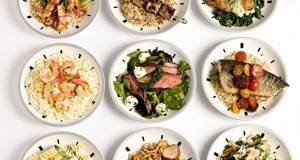
About the diet
The theory of separate nutrition is based on the premise that too complex and varied dishes are difficult to digest, so it is proposed to divide meals by type of food, which is a simplified diet aimed at weight loss, thanks to the correct and balanced distribution of food products. Carbohydrates and proteins are not combined into one meal, while there are no restrictions on the combination of other nutrients.
Different enzymes are involved in the digestion of different foods. If a person simultaneously consumes proteins and carbohydrates, then his body produces both types of enzymes. Since these enzymes need different environments (alkaline or acidic), they begin to counteract each other. Digestion slows down, the usefulness of foods drops sharply, and the entire digestive system works under increased load. The degree of digestibility directly depends on what kind of environment is required for the digestion of a particular product.
Protein products, meat, fish, seafood, eggs, milk, low-fat cheeses, pome fruits (apples, pears, etc.), stone fruits (apricots, cherries, plums, etc.), exotic (except bananas) and citrus fruits require an acidic environment. fruits, berries, fruit teas and juices, cider, dry and semi-dry wines, champagne, soy products, peanuts.
An alkaline environment is needed for carbohydrate products: all cereals, flour products, some vegetables (potatoes, Jerusalem artichoke, parsnips, green cabbage), processed tomatoes and spinach, fresh bananas, dates and figs, dried apricots and figs, raisins, sweets, beer.
Both acidic and alkaline environments are necessary for the digestion of neutral foods: leafy vegetables, onions, any cabbage (except green), legumes, sweet peppers, fresh tomatoes, carrots, rutabaga, beets, eggplants, cucumbers, zucchini, pumpkin, garlic, asparagus, celery, mushrooms, fermented milk products, fatty and curd cheese (feta cheese), various fats, nuts and seeds (except peanuts), avocados, olives, spices, jelly, mineral water, herbal teas, diluted vegetable juices.
The separate nutrition method divides all products into the following groups:
- proteins (from meat to legumes)
- carbohydrates (from potatoes to cereals)
- fats (from butter to sour cream)
- starchy vegetables
- non-starchy vegetables
- sour vegetables
- fruits and berries
- sweet fruits
Why is it better to eat fruits separately?
Fruits are sources of fiber, vitamins and minerals and can cleanse the gastrointestinal tract. But if you eat bread, meat, and then an apple, the fruit will not reach the intestines, but will come into contact with food and gastric juices, disrupting absorption.
Therefore, it is necessary to eat fruits on an empty stomach or before meals. When people complain of heartburn after eating watermelon or diarrhea after eating a banana, they most likely combined them with other foods. Gases are formed, bloating, heaviness and nausea occur. Hair loss, nervous exhaustion and dark circles under the eyes are the results of eating fruit after other foods.
Herbert Shelton says that even sour lemons and oranges become alkaline in the body. Fruits are necessary to maintain normal acid-base balance in the body.
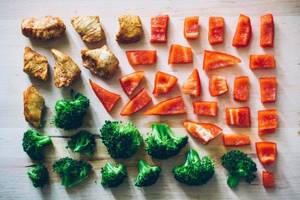
Menu for 20 days
With the help of a separate diet in 20 days you can get rid of 8 kg of excess weight
The first two days are fasting, on kefir, to prepare the body for the diet and cleanse the intestines.
The next 18 days alternate between protein days and vegetable days.
Be sure to drink enough clean water, at least 1.5 liters per day.
- 1st and 2nd day
- During the day
- Divide one and a half liters of one percent or low-fat kefir into five or six doses. During the day you need to drink green tea without sugar and as much water as possible.
- Even day (protein)
- During the day
- Products such as eggs, meat, fish, cottage cheese, dairy products are perfect for the daily diet (menu options can be taken from the weekly diet)
- Not even numbered day (vegetative)
- During the day
- The entire day's diet should consist of vegetables and fruits. The consumption of any combined fruits, dried fruits, vegetables, fruit and vegetable purees and soups is allowed.
Balanced diet
Dietary recommendations call for eating a palm's worth of protein, a fist's worth of whole grains and a handful of vegetables at each meal. One person will live his entire life eating chicken and cereal without experiencing stomach problems. The other will suffer from heaviness.
The presence of different theories regarding the construction of the menu only indicates that each person’s body is unique . Almost all diets, including low-carbohydrate, high-protein, keto diets, as well as the food compatibility theory, were invented to treat gastrointestinal problems. They were not initially considered for weight loss, but helped to learn to choose food consciously, which led to an improvement in a person’s appearance. Therefore, you should not expect that a particular nutritional system will 100% help burn fat. Separate meals, like the food pyramid, teach planning and healthy choices.
About the history of the diet
The idea of dividing all products into compatible and incompatible belongs to the founder of the separate nutrition system, Herbert Shelton. For many years, Shelton collected and analyzed information about which enzymes are used to digest a particular product, as well as how products “neighbor” each other, entering the stomach “in a large group.” It turned out that different products require different conditions for complete processing - this became the main criterion for sorting products according to compatibility and the emergence of the theory of separate nutrition.
In 1928, at the Dr. Shelton School of Health clinic, he cured various serious diseases by proper consumption of foods, fasting, as well as physical activity, exposure to fresh air, sun, clean water, proper rest, sleep, hygiene and control of emotions. G. Shelton died at the age of 100.
Buckwheat pancakes
If we talk about separate meals (recipes), buckwheat should not always be associated with porridge. Why not fry it?
For porridge cooked from one glass of buckwheat, you need to take 3 medium potatoes, one tablespoon of flour, perhaps a little more, salt to taste and spices of your choice, vegetable oil for frying pancakes.
To prepare such pancakes, you first need to boil the buckwheat. Buckwheat should first be washed, then poured with water, you need to take two glasses of it. After boiling, add a little salt, although you can leave it fresh, reduce the heat under the pan and cook for about 20 minutes until tender.
At this time, peel the potatoes and rub through a fine or medium grater. Lightly squeeze the liquid out of it and mix with the finished porridge. Add flour and spices to the mixture. Leave for a few minutes for the dough to settle.
Fry the pancakes on each side in hot oil for 3-4 minutes. It is better to cover the pan with a lid to ensure even cooking. It is best to serve pancakes with sour cream.
Separate meals for weight loss
Compatibility of products for proper nutrition is also very important for losing weight. This is not a diet, it is a special approach that takes into account how one product combines with another. See how the real inhabitants of nature - animals - behave. They do not combine different foods. They don’t fry it or process it. Only a person carries out a lot of manipulations with food before it enters his stomach. This can cause bloating, heartburn or nausea. The problem is that the products are not digested. But they are not assimilated because they do not fit together. The simpler the food, the less processed it is, the fewer different components it contains, the easier it is for the body. When there are no such problems, the excess weight goes away by itself.

Therefore, all you have to do is be more vigilant about cooking and eat only compatible foods at one meal.
Buckwheat with mushroom sauce
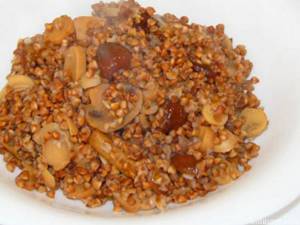
An interesting combination that offers separate meals is buckwheat with mushrooms.
The amount of ingredients needed to prepare 4 servings is:
- for porridge:
- buckwheat in the volume of one glass;
- two glasses of water, since to cook porridge you need to take water in a volume twice as large as the amount of cereal;
- salt and spices as desired;
- for gravy:
- a quarter kilogram of fresh mushrooms;
- about 3 tbsp. spoons of flour;
- one onion;
- oil for frying, maybe butter, it will be tastier;
- 3 glasses of water.
First you need to boil the porridge. Pour water over the cereal, add salt and boil. Cook for about 20 minutes. During this time, the buckwheat will completely absorb the water and cook.
To prepare the gravy, fry the onion until transparent. Add chopped mushrooms to the onion and fry for 10 minutes. Add flour and fry for another 3 minutes. After this frying, the entire contents of the frying pan are filled with water and brought to a boil with continuous stirring. Now it’s the turn of sour cream, salt and spices to go into the frying pan. Simmer the gravy for about 10 minutes more. Place the buckwheat porridge into portioned plates and pour over the gravy.
